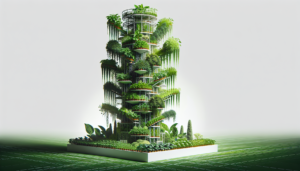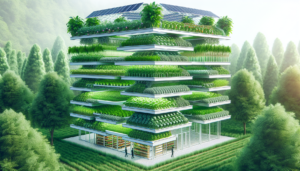
Have you ever wondered about the benefits and drawbacks of vertical farming? In this article, we will take a closer look at the advantages and disadvantages of this innovative agricultural technique. Vertical farming offers the potential to revolutionize food production by using vertical space to grow crops indoors, but it also presents unique challenges. By examining both the pros and cons of vertical farming, we can gain a better understanding of its potential impact on the future of agriculture.
Advantages of Vertical Farming
Increased Crop Yield
Vertical farming offers the advantage of significantly increased crop yield compared to traditional farming methods. By utilizing vertical space, multiple layers of crops can be grown, resulting in a higher production output per square foot. This is especially beneficial in urban areas where land is limited and expensive. Vertical farming maximizes the potential of each space, allowing for a higher volume of crops to be grown and harvested.
Year-round Production
One of the most significant advantages of vertical farming is the ability to cultivate crops year-round, regardless of the external weather conditions. By creating a controlled indoor environment, vertical farms can maintain optimal growing conditions throughout the year, eliminating the dependence on seasonal changes. This constant production ensures a stable and reliable food supply, reducing the risk of crop shortages during specific seasons or adverse weather events.
Optimal Use of Space
Vertical farming utilizes space much more efficiently compared to traditional farming methods. By growing crops in multi-tiered systems, vertical farms can maximize the productive capacity of each acre. This is especially important in densely populated urban areas, where available land for agriculture is limited. Vertical farming allows for the cultivation of a greater volume of crops in a smaller footprint, making it an ideal solution to address the growing global food demand.
Reduced Water Usage
Water scarcity is a global concern, and traditional agriculture often requires a significant amount of water for irrigation. Vertical farming addresses this issue by implementing advanced irrigation systems that optimize water usage. By utilizing techniques such as hydroponics or aeroponics, where crops are grown without soil and with minimal water, vertical farms can conserve water resources. This reduction in water usage not only alleviates pressure on freshwater supplies but also makes vertical farming a more sustainable and environmentally friendly solution.
Less Dependency on Weather Conditions
Vertical farming provides a major advantage by reducing the dependency on weather conditions for crop production. In traditional agriculture, adverse weather events like droughts, floods, or extreme temperatures can have devastating effects on crops. Vertical farms, on the other hand, create a controlled indoor environment where temperature, humidity, and light are carefully regulated. This protection from unpredictable weather conditions ensures a stable and consistent crop yield, minimizing the risks associated with climate change and extreme weather events.
Protection from Pests and Disease
Pests and diseases pose significant challenges to traditional farming, often resulting in reduced yields and economic losses. Vertical farming offers an advantage in pest and disease management by providing a controlled, enclosed environment that minimizes the risk of infestations. With strict monitoring and preventive measures, such as the use of integrated pest management techniques and reduced pesticide usage, vertical farms can effectively protect crops from harmful pests and diseases. This not only ensures higher crop quality but also reduces the need for chemical interventions, making vertical farming a safer and healthier option for consumers.
Enhanced Food Safety
Vertical farming prioritizes food safety by implementing strict quality control measures. With complete control over the growing environment, vertical farms can eliminate or minimize the use of pesticides and chemical fertilizers, ensuring that the produce is free from harmful residues. Furthermore, the enclosed nature of vertical farms reduces the risk of contamination from external sources, such as air pollution or animal waste. This commitment to food safety reassures consumers that the produce they consume is healthy, clean, and free from potential hazards.
Reduced Carbon Footprint
Conventional agricultural practices, including transportation and energy consumption, contribute significantly to greenhouse gas emissions. Vertical farming offers a solution to reduce the carbon footprint of food production. By locating farms closer to urban areas, vertical farming minimizes the need for long-distance transportation, reducing emissions from transportation vehicles. Additionally, vertical farms often employ energy-efficient technologies, such as LED lighting and renewable energy sources, to optimize energy consumption. This focus on sustainability helps mitigate climate change and promotes a greener future.
Promotes Sustainable Agriculture
Vertical farming aligns with the principles of sustainable agriculture by addressing various environmental challenges associated with traditional farming methods. The efficient land use, reduced water consumption, and minimized use of agrochemicals make vertical farming a more sustainable choice. The controlled environment also allows for the recycling of water and nutrients, reducing waste and minimizing the negative impact on surrounding ecosystems. By embracing sustainable practices, vertical farming contributes to the conservation of natural resources and the preservation of biodiversity.
Improved Access to Fresh Produce
In urban areas, access to fresh produce can be limited, especially in food deserts where supermarkets and grocery stores are scarce. Vertical farming provides an opportunity to address this issue by establishing farms within or near cities. These farms can supply fresh, locally grown produce year-round, ensuring that urban populations have access to nutritious food options. By reducing the reliance on long-distance transportation and the associated costs, vertical farming enhances food security and promotes healthier eating habits within communities.
Disadvantages of Vertical Farming
High Initial Investment
One major disadvantage of vertical farming is the substantial initial investment required to set up the infrastructure and technology. The costs associated with constructing climate-controlled buildings, installing advanced growing systems, and acquiring specialized equipment can be significant. While the long-term benefits of vertical farming often outweigh the initial investment, the financial barrier can pose a challenge for individuals or organizations with limited resources.
High Operating Costs
Vertical farming involves ongoing operational expenses that can be higher compared to traditional farming methods. The continuous need for electricity to power artificial lighting, maintain the optimal environment, and operate complex irrigation and ventilation systems contributes to the higher operating costs. Additionally, the specialized knowledge and expertise required to manage and operate a vertical farm may also result in higher labor expenses. These operating costs must be carefully considered and managed to ensure the economic viability of vertical farming ventures.
Complex Technology and Infrastructure
Vertical farming relies heavily on advanced technology and complex infrastructure to create and maintain the ideal growing conditions. The integration of systems for climate control, irrigation, lighting, and nutrient delivery requires specialized knowledge and expertise. The complexity of managing these technological components can present a steep learning curve for farmers and operators transitioning from traditional methods. Furthermore, the maintenance and repair of these systems can pose logistical challenges, requiring skilled technicians and spare parts to prevent disruptions in crop production.
Energy Intensive
The energy requirements of vertical farming can be substantial. Artificial lighting, necessary to provide plants with the required amount of light for photosynthesis, consumes a significant amount of electricity. The maintenance of optimal temperature and humidity levels within the controlled environment also demands energy consumption. While advancements in energy-efficient technologies, such as LED lighting, are improving the energy efficiency of vertical farms, the high energy intensity remains a disadvantage that needs to be carefully managed to minimize environmental impacts.
Limited Crop Variety
Vertical farming prioritizes high-value, leafy greens and herbs due to their suitability for vertical cultivation. However, the diversity of crops that can be grown in vertical farms is relatively limited compared to traditional farming methods. Crops with large root systems or those that require extensive horizontal space, such as certain fruits and grains, may be challenging to grow vertically. While ongoing research and technological advancements aim to expand the range of crops viable for vertical farming, the current limitations may restrict the variety of produce available from vertical farms.
Dependency on Artificial Lighting
Unlike traditional farming, vertical farming requires artificial lighting to supplement or replace natural sunlight. Providing adequate light for plant growth can be energy-intensive, as mentioned earlier. Furthermore, replicating the full spectrum and intensity of natural sunlight remains a challenge. While LED lighting is a more energy-efficient option, it may not completely replicate the complex interaction between plants and sunlight, potentially affecting plant growth and nutritional profiles. Balancing the use of artificial lighting and the need for natural sunlight is an ongoing challenge for vertical farmers.
Reliance on Continuous Power Supply
Vertical farms heavily depend on a continuous and reliable power supply to maintain the controlled environment. Any disruption in power supply, such as blackouts or electrical failures, can have detrimental effects on crop production and overall farm operations. Backup power systems, such as generators or battery storage, need to be in place to prevent crop losses and ensure the farm’s resilience. The need for uninterrupted power supply adds an extra layer of complexity and cost to the operations of vertical farms.
Challenges with Scaling
While vertical farming has proven successful on a smaller scale, scaling up operations can present significant challenges. Expanding vertical farming into larger facilities or multiple locations requires substantial investment, expertise, and management capabilities. The synchronization of various crop cycles, managing logistics, and ensuring consistent product quality across different facilities can be complex. Additionally, regulatory hurdles and zoning restrictions may pose barriers to expanding vertical farming ventures. Overcoming these challenges is crucial to realizing the full potential of vertical farming in meeting global food demands.
Requires Expertise and Monitoring
Successful vertical farming requires a high level of expertise and constant monitoring. The intricate interplay between environmental factors, such as temperature, humidity, and lighting, requires skilled operators who can make timely adjustments to maintain optimal growing conditions. Understanding the specific needs of different crops, managing irrigation systems, monitoring nutrient levels, and diagnosing and addressing any pest or disease issues require knowledge and experience in vertical farming practices. Investing in training and continuous learning is essential for the success of vertical farming operations.
Perceived Aesthetics
One aspect that some individuals may perceive as a disadvantage of vertical farming is the perceived lack of aesthetic appeal. Traditional farming, with its picturesque fields and landscapes, often evokes a romanticized image of agriculture. Vertical farming, with its indoor, structured environment, may not offer the same visual appeal. However, it is important to recognize that vertical farming focuses on maximizing productivity and efficiency, prioritizing function over aesthetics. The benefits it offers in terms of increased crop yield, reduced environmental impact, and improved food security outweigh the perceived aesthetic concerns for many proponents of vertical farming.
In conclusion, vertical farming presents numerous advantages that address key challenges of traditional agriculture. The increased crop yield, year-round production, efficient space utilization, reduced water usage, and protection from weather, pests, and diseases make it an attractive solution for sustainable food production. However, it is essential to consider the disadvantages, such as high initial investment and operating costs, complex infrastructure and technology, energy intensity, limited crop variety, and the need for expertise and monitoring. Despite these challenges, vertical farming has the potential to revolutionize agriculture, enhance food security, and contribute to a more sustainable future.







